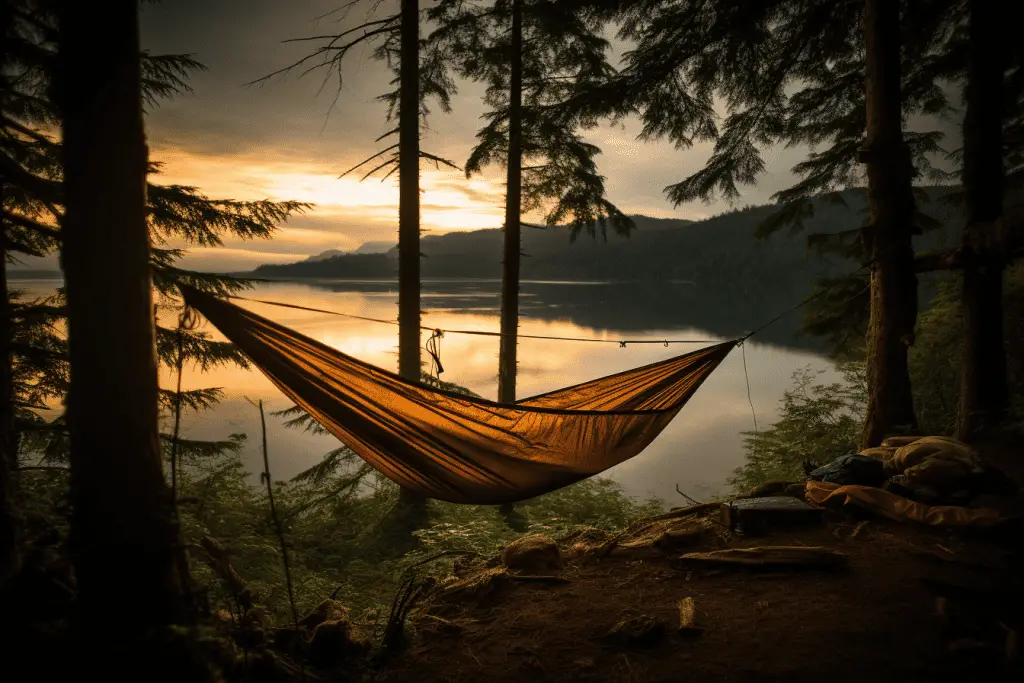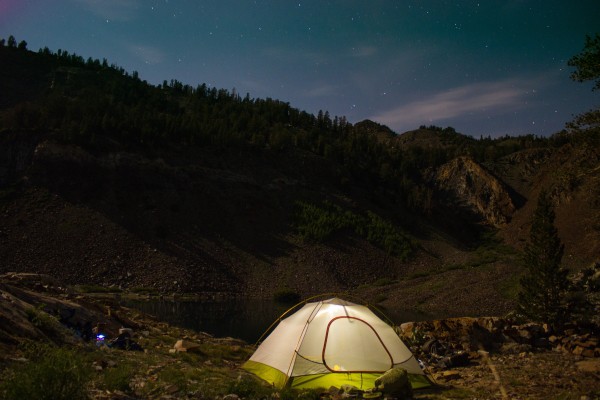Should you go tent camping or hammock camping? In this post, you’ll find out.
Let’s get right to it!

Advantages of Tent Camping Vs Hammock Camping
- Easy Setup
- More Space
- Community Camping
- Amenities
- Better Wind Resistance
- Entry and Exit
Setting Up A Tent
Setting up a tent instead of a hammock has its advantages. For starters, you don’t have to worry about finding two or three trees. This means you can tent camp on beaches, in deserts, and in many other areas where you simply wouldn’t be able to set up a hammock for camping.
On top of this, setting a tent up is usually a bit more intuitive than setting a hammock up. A person who is completely new to camping can usually buy a tent and easily set it up correctly without any problems.
New hammock campers may have to do some research on knot tying before they head out. Additionally, they’ll need to learn how how to tie their hammocks and where to tie them so that they can get in and out of them comfortably.
Space
Even a small tent will provide a lot more space than a hammock. This space can be used to stretch out, to bring gear inside, or just to lounge in. Leisurely camping trips and backpacking trips with zero days built into them can really benefit from the additional space that a tent has to offer.
The additional room really comes in handy on rainy or snowy days. A tent gives you the ability to sit up, cook, go through your gear, clean up, and do all sorts of other things without going outside. Hammocks just can’t provide this kind of space.

Community Camping
Tents also give you the option of sleeping with others. This is great for couples or people traveling with small children who don’t want to sleep alone. In fact, a large tent can offer enough space inside of it to sleep an entire family.
These large tents can house wood stoves for heating and cooking, tables, chairs, and even cots. Camp with a large tent and you can use it to create a community hub for everyone on the trip. You’ll all be able to hang out, eat, play cards, play board games and whatever else you might want to do inside.
Amenities
As we just mentioned, a tent gives you the option of bringing additional amenities with you. While you probably won’t be dragging large camp chairs or cots out with you on a backpacking trip, you may want to bring them along on car camping trips. A big tent will allow you to do this.
Some tents will even feature additional rooms that you can use to put portable toilets or portable kitchens inside. No matter how big your hammock is, you won’t be doing this with it.
Wind Resistance
Small backpacking tents often sit low to the ground. This makes them less vulnerable to the wind. What this means is that the tent is quieter to sleep in and it’s warmer and more comfortable to hang out in.
Hammocks, on the other hand, can’t sit close to the ground. A hammock is suspended from a tree which means it’s likely to sway in the wind. For some people, this can be extremely relaxing. Other people, however, might feel like they need to take a Dramamine pill before heading off to sleep.
Entry and Exit
Getting in and out of a tent versus a hammock can be an advantage or a disadvantage depending on your tent and your particular body. A large tent is easy to get in and out of since you can basically just walk through it. Smaller tents, on the other hand, may force you to crawl in and out.
With a hammock, you don’t have either of these options. You have to either sit into them or climb into them. Either way, they can often be hard to get out of. This can be especially annoying for those middle of the night trips into the bushes.
Advantages of Hammock Camping Vs Tent Camping
- Easy Setup
- Weight
- Smaller Footprint
- Replaces Gear
- Comfort
- Natural Foot Elevation
Easy Setup
Sometimes hammocks will be easier to set up than tents. This is because hammocks don’t care if the ground is rocky or unlevel. They also don’t care whether or not the ground is wet.
With tent camping, you have to find a relatively level area that is free from bugs, rocks, sticks, and all sorts of other things that can affect your tent. You also have to worry about water issues. Place your tent in a low area and you may end up waking up in a puddle of water. Worse yet, you could accidentally set up in a flood-prone area and get washed out of your campsite. On top of all of this, you’ll also need to find an area that is soft enough to get your stakes into the ground. Fail to do this on a windy day and your tent could end up blowing over or away from you.
Of course, setting the hammock up for the first time could be challenging. You’ll have to learn some knots and some of the basic rules for hammock camping. However, once you’ve gotten some experience setting up your hammock, it won’t be much more difficult than setting up a tent and in some cases, it may even be easier to set up your hammock than to set up your tent.
Hammock Weight Vs Tent Weight
A good backpacking hammock can weigh next to nothing when compared to a good backpacking tent. Hammocks like the Hummingbird Single weigh in at less than 6 ounces. Even an ultralight camping tent is going to weigh five or six times that much. An average backpacking tent will probably weigh more like ten times that much.
While saving a few pounds on a car camping trip isn’t going to do much for you, these same few pounds can have a big impact on a long-distance backpacking trip. For some people, three extra pounds could be the difference between an injured knee and a healthy one. For other people, the extra pounds could be the difference between finishing a hike on time or having to call it quits. In short, never underestimate a piece of gear that can cut down on the amount of weight you have to carry.
Smaller Footprint
Hammocks usually take up less space than tents. Not only does this give you more space to bring along other items, but it also cuts down on the weight of your pack as well. This is because, with a smaller footprint, you’ll be able to carry a smaller and lighter backpack.
The advantage of the hammock’s smaller footprint doesn’t begin and end on the trail. Having smaller gear means more space in your closet at home and more space in your car while on the road.

Hammocks Can Reduce The Amount of Gear You Need
Hammocks don’t need to be staked and they don’t need trenches created around them in the rain. As a result, you may find that you can leave some tools behind. For example, some people bring an entrenching tool with a pickaxe to create trenches. Others bring a mallet with them while car camping to drive stakes into the ground. You won’t need either of these tools to set up your camping hammock.
A hammock can also act as a seat. This means car campers can leave their camping chairs at home and still have a comfortable place to sit while at camp.
Additional Comfort
Many people find that sleeping on the ground doesn’t suit them. Even with a camping pad, the hard ground hurts their backs and leaves them with sore joints. Hammock campers don’t sleep directly on the ground so they don’t have to worry about this.
Different hammocks will offer different levels of comfort, just like different tents and sleeping pads will offer different levels of comfort as well. However, if you’re looking for the most comfortable sleeping arrangement with the least amount of gear, a camping hammock is a better option than a camping tent for most people.
Natural Foot Elevation
If you’ve gone long-distance hiking, you’re probably familiar with edema in the legs and feet. This is when fluid builds up in your lower extremities and it happens quite often to hikers.
The simple solution to dealing with hiking edema is to elevate your feet to the level of your heart while you sleep. This helps your body remove this excess fluid. The way hammocks are designed, your feet will naturally sit higher than your heavier torso, so you’ll end up dealing with your edema naturally.
One word of caution on this, however, is that this could cause you to have to relieve yourself. This can be inconvenient in the middle of the night so I’d suggest that you lay with your feet elevated for an hour or two before you actually go to sleep. Do this and you should be able to remove this excess water before you head to sleep for the night.
Additional Thoughts
Hammock camping and tent camping both have their plusses and minuses. Luckily, you don’t have to choose one or the other.
If you’re unsure which to choose, my personal preference is to use hammocks when going on long-distance hikes through forested trails or in wet areas. I’ll opt for a tent when beach camping, car camping, or camping in areas where good trees may be hard to find.

